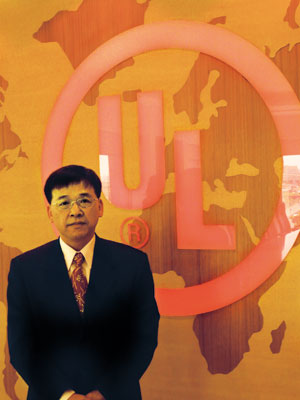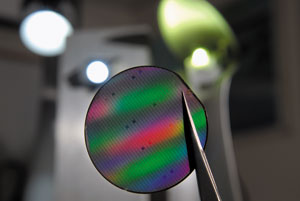UL Certification Boosts Taiwan's LED Lighting Industry
2009/06/05 | By Ken LiuLED lighting fixtures have accounted for fully half of all Underwriters Laboratories (UL) approvals in Taiwan, reports the Taiwan branch of the safety certification organization. Worldwide, the ratio averages 30%.
Taiwan's UL branch recently worked with the government-supported Industrial Technology Research Institute (ITRI) to certify ITRI's alternating current (AC) LED light source modules and components under UL's Subject 8750, completing the world's first North American UL verification of semi-finished and finished AC LED light sources.
"I would say that these developments give people the idea that LED is positioning to take the place of traditional light sources," comments Ralph Tang, managing director of UL Taiwan Co. "UL applications filed by LED manufacturers have increased worldwide, and LED technology and efficiency are constantly improving."
Taiwan is now a major player in the global LED industry. According to the local Topology Research Institute, a market research firm, Taiwan supplies 26% of the worldwide demand for LED devices, second only to Japan. The island's LED revenues are expected to reach NT$74 billion (US$2.1 billion at NT$34;us$1) this year, up about 20% from 2008. Worldwide, the annual growth rate is 15.7%.
UL worked out its safety-verification standard specifically for LED devices as light source, dubbed Subject 8750, in 2005. The verification standards applied to other lighting products are unsuitable for use with LEDs, Tang explains, because of differences in the way they are constructed.

Insulation is usually the main issue that UL addresses for high-voltage electrical appliances, says Peter Lee, director of UL Taiwan's conformity assessment service department. "With AC LED products," he notes, "the distance between anode and cathode needs to be widened, and this is the main consideration of 8750."
"Actually, just as with other UL standards, the core concern of Subject 8750 is minimum safety requirements to prevent hidden dangers such as short circuiting, shock, and cutting injuries," Tang explains. "So this standard entails inspection of not just light sources and power components, but also materials; the idea is to keep consumers from being cut by the sharp edges that might be formed by some materials."
A UL Taiwan publication reports that the construction chapters in 8750 put emphasis on environmental considerations, mechanical construction, electrical construction, LED power sources, and LED components.
To accommodate the growing scope of LED lighting applications, last year the UL sorted LED lighting products into seven categories: LED modules, LED drivers, LED energy-saving lamps, LED cabinet lights, portable LED lights, fixed-type LED lighting fixtures, and LED downlights.
"When the UL learned about our AC LED technology in 2007," recalls Dr. Y.W. Yeh, deputy director of the opto-electronics device and system application division of ITRI's Electronics and Optoelectronics Research Laboratories (which developed technology), "it approached us regarding the plan to carry out AC LED verification under Subject 8750. We wanted to understand the requirements of the draft standard better so that we could help our domestic LED-lighting manufacturers win UL approval, so we accepted the offer."

Although the draft standards did not exist when ITRI worked out its AC LED technology, the technology was developed in reference to the UL standards that existed at the time and so conforming with the new standards was not difficult. And, thanks to the cooperation between the two organizations on AC LED verification, ITRI has become the only Taiwanese member of the UL8750 committee. This gives ITRI a voice in the drafting of the UL's AC LED requirements.
Yeh says that so far, Seoul Semiconductor, Philips, Forward Electronics, and Liquidleds Lighting have so far won UL approval for their AC LED lighting products, with Forward licensing the technology from Yeh's organization.
UL also teamed up this March with Luminaire Testing Laboratory (LTL), initiator of the "Energy Star" standard, becoming the world's first inspection institution to carry out Energy Star verification of LED lighting products.
"For the more than 100 years since the UL was founded," Tang comments, "the safety standards that it has developed have become the national standards for the United States and have been borrowed by other countries as a reference in setting their own standards." For this reason, Subject 8750 will likely become a primary reference in the development of their own LED lighting verification standards by other countries.
In addition to its inspection labs, UL also has R&D laboratories. "It's hard to find another inspection institution anywhere in the world that has R&D laboratories like UL does," Tang stresses. "The UL now operates R&D laboratories only in the U.S. and Taiwan, mainly because Taiwan's economy depends heavily on exports and the U.S. has traditionally been its biggest export market." The R&D labs (the Taiwan branch has 109 R&D engineers) do research on materials and products that might be a threat to users in order to establish reasonable safety standards for inspection work.
Its growing network of partnerships with other institutions around the world enables the UL to offer inspection services not only for its own standards but also for the standards of its partner institutions. This operation is, Tang says, a "one-stop-testing" service that allows manufacturers to test their products and obtain approval in UL laboratories locally, saving them a lot of time and money to have verification done overseas.




